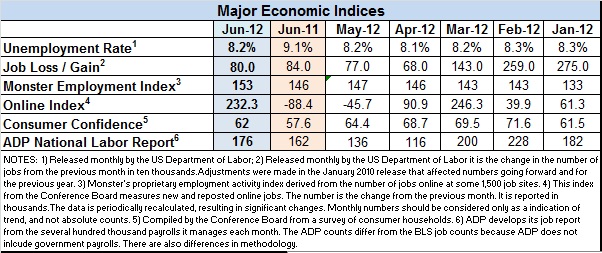It could have been worse may be the best way to describe this morning’s jobs report from the U.S. Department of Labor.
The government said 80,000 non-farm jobs were created in June, fewer than the 90,000-100,000 surveys predicted, but better than the more dire predictions, and an improvement — slight though it is — over April and May.
The unemployment rate remained at 8.2 percent, unchanged now for the second month and only barely better than the 8.3 percent that kicked off the year. Adjustments to the initial government numbers for April and May subtracted a net of 1,000 jobs from the reported 146,000.
Weak private sector job growth in June
The private sector, which was expected to have created as many as 110,000 jobs, generated a mere 84,000, less than half the 176,000 forecast just yesterday by an ADP report. Only some of the most aggressive hiring by local governments in months — presumably for summer work — helped keep the overall jobs numbers from falling further. Local governments added 18,100 new workers.
June capped the worst quarter in two years for hiring, and was way off the average of 226,000 monthly new jobs in the first quarter. From April through June the U.S. economy averaged 75,000 new jobs a month, a mere 3,000 ahead of 2010 and far behind last year’s average of 130,000.
 “Slower job growth in the second quarter occurred in most major industries,” said the Labor Department report.
“Slower job growth in the second quarter occurred in most major industries,” said the Labor Department report.
While other reports and surveys point to improved hiring now and in the months ahead, the government data suggests that the pattern of slow hiring in the summer months will continue this year. In addition, SHRM’s new LINE report says July isn’t going to offer any help. SHRM says, “In July, the hiring rate will rise slightly in manufacturing and drop sharply in services compared with a yea ago.”
The New York Times says that the average of a survey of economists shows only about 130,000 new jobs are expected each month through the end of the year.
Little difference in may, June reports
Except for a few strong growth areas — temporary workers increased by 25,000; manufacturing by 11,000; healthcare by 13,000; wholesale trade up 9,000, and; computer hiring by 7,000 — there really wasn’t much difference from May to June.
Average hourly earnings for all employees on private nonfarm payrolls increased by 6 cents to $23.50. Over the year, the report says, average hourly earnings have increased by 2.0 percent. In June, average hourly earnings of private-sector production and nonsupervisory employees increased by 5 cents to $19.74.
The total count of the unemployed was 12.7 million in June, unchanged from May. Another 8.2 million are working part-time because they can’t find full-time jobs, and 2.5 million more aren’t working, but looked for a job recently, though not during the survey period and weren’t, therefore, officially counted as unemployed.
The U.S. Bureau of Labor Statistics, which compiles the data from monthly surveys of homes and businesses, adjusted its jobs count for the months of April and May. April, initially reported at 77,000 new jobs, went down to 68,000. May, which came in at 69,000, was upped to 77,000. The net change was -1,000.
